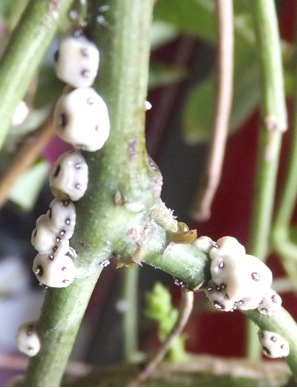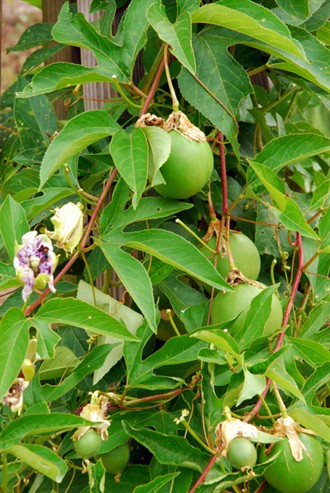Can passion for a plant fortify the gardener oppressed by scale
control?!
Looking at waxy bumps on a plant? We had this e-conversation
with a gardener about his blue passion flower vine (Passiflora
caerulea) but it would all apply to holly, euonymus, camellia,
boxwood and lots of other plants this un-American pest can attach
itself to.
T.C.: My passion flower is covered with
these.....thousands of them! Do you know what it is?
J&S: Looks like a scale
insect. We're checking for a particular name. Are they all over the
stems, or concentrated anyplace?
T.C.: The little buggers are ALL OVER.
J&S: Looks like one of the Ceroplastes species of scale. We'll
call it barnacle wax scale (C.cirripediformis) although it
could be a close cousin called Florida wax scale (C.
floridensis, also called citrus wax scale). Differentiating between the
two isn't critical right now since the immediate treatment is the
same for both.
A scale afflicted plant shows the strain by paleness or losing
leaves. Leaves or twigs may have spots or smears of sticky scale
excrement called honeydew (at arrow, below) which then grows dark
from sooty mold. Notice early and you'll see the scales as red
crawlers or small white smears just beginning to get waxy. The
scales you photo'd (thanks for the use of such clear photos) have
been at work a while, sucking on the stems. They are adults with
significant wax protection.


Armored scales such as wax scales begin life as mobile,
unshielded crawlers but eventually settle down, attach themselves,
lose their legs and (above, left) begin building a protective waxy
coating.
Above, right: Once the scales are this old, pesticides may
roll right off of them. At this point they are eating less than
they were as crawlers, relative to their body mass so it's harder
to deliver a lethal dose. They will produce eggs which remain under
their armor . That double layer of protection -- "mom's" wax coat
plus the egg case -- means the next time an insecticide can be
reasonably effective is when the eggs open and the crawlers come
out from under.
Controlling
them:
As with all insects, the older the critter the harder it is to
kill. However, a direct dose of rubbing alcohol can work. Use a rag
and alcohol or a cotton-tipped swab dipped in alcohol (as for
mealybug, illustrated in
What's Coming Up #77). You can even spray alcohol on the
whole plant, but only if the plant's out of the bright light and
you rinse it a few minutes afterward so it won't burn the
foliage.
Follow up after a few days and then after another week or so,
repeating the swab or spray where scales remain. Some always
survive that were in tight crannies -- shielded by the plant -- or
because they were not yet emerged from the sheltering egg.
T.C.: !!! The vine is 24 feet long......... I usually
cut it back to 2 feet to over-winter inside.
J&S: Once it's cut to a couple of feet for winter, there's a
lot less spraying and cleaning to do! Even during the growing
season you could have pruned to remove the worst infested
stems.
An option is to spray with
a systemic insecticide. The plant absorbs that and
then the insects ingest the poison as they chew or suck. Merit and
Orthene are two examples, based on active ingredients imidacloprid
and acephate, respectively.
Systemic insecticides are not very effective, however, on scales
nearing maturity. Adults don't ingest enough to be killed but even
if they do, eggs already in place under the dead scale's shell
remain, protected.
T.C.: Thanks, but I will toss it.
J&S: Even so, follow up in late winter or early spring to
derail a repeat performance.
The scales in this
genus can host on a great many plant species and
types, woody and herbaceous, tropical and temperate.**
Young scales are not fixed like the waxy adults but can crawl off
to live on adjacent plants including holly, Euonymus,
Schefflera, Aglaonema, Hibiscus, citrus
trees, Artemisia, banana, fig, English ivy, boxwood,
apples, pears, cherries, peach, maples, magnolia and dozens
more.
**Insects that Feed on Trees and Shrubs, Warren
Johnson and Howard Lyon, 1991
So be suspicious of any plant that was cozy with that infested
passion vine. Discard those others, or cut them back and clean them
well. Then watch carefully at the start of your next local scale
season for sticky surfaces or pale leaves. Be ready to act earlier
rather than later.
Essential
follow-up: Same tale as for many other scales!
Indoors and in warm, no-freeze climates, be on guard for new wax
scales in February. Watch for crawlers in mid- to late May in the
garden (as far north as Ohio and New York where barnacle wax scale
females survive winter outdoors and lay eggs in spring). In either
case the date is variable depending on temperature. Watch for sticky
honeydew or the tiny crawlers themselves. Use a soap spray, oil
or other insecticide to kill these vulnerable young-uns. Over the
next two to three weeks, repeat as appropriate to your tactic to
kill later-emerging crawlers.
On a plant in a subtropical area or overwintered warm, wax
scales can do this generational shift change more than once a year
-- twice for barnacle wax scale, three times for Florida wax
scale.


Passion flower (Passiflora incarnata) should be
leafy all over (above, left, healthy and fruiting). The second vine
(above, right) dropped leaves all during its scale infestation.
Investigate when the leaf fall begins and you may fend off
the trouble.